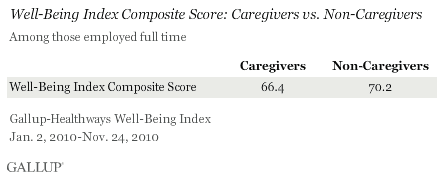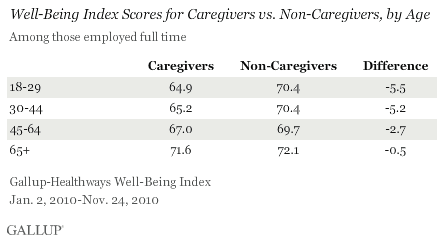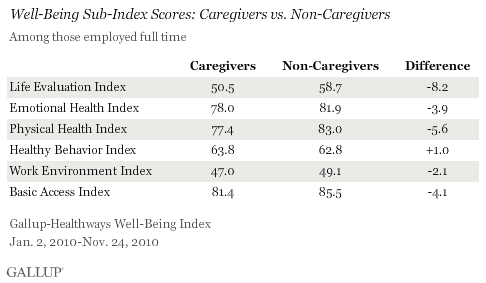This article is the first in a special multipart series on caregiver well-being in America.
WASHINGTON, D.C. -- Americans who work a full-time job and say they care for an elderly or disabled family member, relative, or friend -- 16% of the full-time workforce -- suffer from lower well-being than those who work a full-time job but do not have additional caregiving responsibilities. Caregivers' 66.4 overall well-being score is significantly lower than the 70.2 among non-caregivers.

These findings are based on 140,853 interviews with American adults employed full time conducted Jan. 2-Nov. 24, 2010, as part of the Gallup-Healthways Well-Being Index. Of these respondents, 23,520 self-identified as caregivers based on their response to the question "Do you currently help care for an elderly or disabled family member, relative, or friend, or not?"
The Gallup-Healthways Well-Being Index score comprises six sub-indexes, which measure how Americans rate their lives, emotional health, work environment, physical health, healthy behaviors, and access to basic necessities.
Negative Effects of Caregiving Greatest for Young Adults
Six percent of caregivers who are employed full time are aged 18 to 29, 22% are aged 30 to 44, 65% are between the ages of 45 and 64, and 6% are aged 65 and older.
Working Americans between the ages of 18 and 29 -- although the least likely to be caregivers -- feel the negative effects of caregiving more than any other age group. Well-being scores drop from 70.4 among working non-caregivers aged 18 to 20 to 64.9 among those of the same age who are caregivers.
The difference in well-being between working caregivers and non-caregivers declines as Americans get older, with essentially no difference in well-being scores among those aged 65 and older.

Caregivers Do Worse on Five of Six Key Areas of Well-Being
Caregivers score worse than non-caregivers on five of the six well-being sub-indexes. The greatest differences are in terms of life evaluation, physical health, and access to basic necessities. Caregivers, however, report more healthy behaviors than do non-caregivers.

Implications
The one in six American adults who are employed full time and identify themselves as caregivers have significantly lower well-being compared with those who work full time but don't carry the additional caregiving responsibility. The deleterious effects of caregiving on a person's emotional and physical health may be because of the added responsibilities, physical demands, and emotional burdens associated with such a role. Furthermore, these effects likely vary based on the intensity of the need of the person requiring care and the nature of the condition, from Alzheimer's and dementia to physical disability.
A recent study of Well-Being Index data by Joseph Coughlin, Ph.D., the founder and director of the Massachusetts Institute of Technology AgeLab, found that caregivers experience more daily stress and worry and less happiness and enjoyment than non-caregivers, and they are more likely to report having been diagnosed with depression. Coughlin also found that these conditions worsened substantially among the unemployed for both groups.
At the same time, it is possible that caregivers are somewhat predisposed to lower well-being than non-caregivers, as they are slightly less educated and have somewhat lower income. These realities may reduce options regarding outsourcing caregiving and could increase the likelihood that people with lower well-being to begin with could ultimately end up serving in a caregiving role.
Interestingly, Well-Being Index data suggest that the potentially negative impact of caregiving on well-being decreases with age, even as the demands of career, family, saving for retirement and college tuition, and declining physical health typically become more profound. That young people, particularly those younger than 30, have substantially lower well-being than their counterparts who are non-caregivers reveals a risk group perhaps in the greatest need of support and resources to maintain their well-being.
About the Gallup-Healthways Well-Being Index
The Gallup-Healthways Well-Being Index tracks U.S. well-being and provides best-in-class solutions for a healthier world. To learn more, please visit well-beingindex.com.
Results are based on telephone interviews conducted as part of the Gallup-Healthways Well-Being Index survey Jan. 2-Nov. 24, 2010, with a random sample of 140,853 adults employed full time, aged 18 and older, living in all 50 U.S. states and the District of Columbia, selected using random-digit-dial sampling. Of this sample of respondents, one-sixth self-identified as caregivers. Nearly two-thirds of all caregivers are between the ages of 45 and 64.
For results based on the total sample of caregivers, one can say with 95% confidence that the maximum margin of sampling error is ±0.6 percentage point. For smaller groups, such as caregivers aged 18 to 29 and 65 years old and older, the maximum error range is about ±3 percentage points.
Interviews are conducted with respondents on landline telephones and cellular phones, with interviews conducted in Spanish for respondents who are primarily Spanish-speaking. Each daily sample includes a minimum quota of 150 cell phone respondents and 850 landline respondents, with additional minimum quotas among landline respondents for gender within region. Landline respondents are chosen at random within each household on the basis of which member had the most recent birthday.
Samples are weighted by gender, age, race, Hispanic ethnicity, education, region, adults in the household, cell phone-only status, cell phone-mostly status, and phone lines. Demographic weighting targets are based on the March 2009 Current Population Survey figures for the aged 18 and older non-institutionalized population living in U.S. telephone households. All reported margins of sampling error include the computed design effects for weighting and sample design.
In addition to sampling error, question wording and practical difficulties in conducting surveys can introduce error or bias into the findings of public opinion polls.
For more details on Gallup's polling methodology, visit https://www.gallup.com/.
